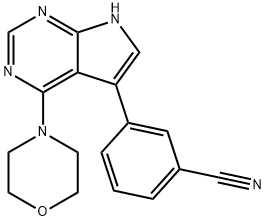- PF-06447475
-

- $43.00 / 5mg
-
2025-07-11
- CAS:1527473-33-1
- Min. Order:
- Purity: 99.62%
- Supply Ability: 10g
- PF-06447475
-

- $1.00 / 1KG
-
2019-09-06
- CAS:1527473-33-1
- Min. Order: 1KG
- Purity: 97%
- Supply Ability: 20kg
|
| | PF-06447475 Basic information |
| Product Name: | PF-06447475 | | Synonyms: | PF-06447475;3-(4-morpholino-7H-pyrrolo[2,3-d]pyrimidin-5-yl)benzonitrile;3-[4-(4-Morpholinyl)-7H-pyrrolo[2,3-d]pyrimidin-5-yl]-benzonitrile;3-(4-morpholin-4-yl-7H-pyrrolo[2,3-d]pyrimidin-5-yl)benzonitrile;PF 06447475;PF06447475;CS-1734;PF-06447475, >98%;Benzonitrile, 3-[4-(4-morpholinyl)-7H-pyrrolo[2,3-d]pyrimidin-5-yl]- | | CAS: | 1527473-33-1 | | MF: | C17H15N5O | | MW: | 305.33 | | EINECS: | | | Product Categories: | Inhibitors | | Mol File: | 1527473-33-1.mol |  |
| | PF-06447475 Chemical Properties |
| Melting point | >223°C (dec.) | | density | 1.40±0.1 g/cm3(Predicted) | | storage temp. | room temp | | solubility | DMSO: soluble10mg/mL, clear | | pka | 12.96±0.50(Predicted) | | form | powder | | color | white to beige | | InChI | InChI=1S/C17H15N5O/c18-9-12-2-1-3-13(8-12)14-10-19-16-15(14)17(21-11-20-16)22-4-6-23-7-5-22/h1-3,8,10-11H,4-7H2,(H,19,20,21) | | InChIKey | BHTWDJBVZQBRKP-UHFFFAOYSA-N | | SMILES | C(#N)C1=CC=CC(C2C3=C(N4CCOCC4)N=CN=C3NC=2)=C1 |
| Hazard Codes | T | | Risk Statements | 25 | | Safety Statements | 45 | | RIDADR | UN 2811 6.1 / PGIII |
| | PF-06447475 Usage And Synthesis |
| Uses | PF 06447475 is a highly potent LRRK2 kinase inhibitor. Highly selective, and mobile, it is used in the treatment of Parkinson’s disease which has been linked to Leucine rich repeat kinase 2 (LRRK2) enzymes. | | Synthesis | 1. In a dry reaction flask, morpholine (871 mg, 10 mmol) and N,N-diisopropylethylamine (2.6 g, 20 mmol) were sequentially added to a solution of n-butanol (100 mL) containing 3-(4-chloro-7H-pyrrolo[2,3-d]pyrimidin-5-yl)benzonitrile (2.5 g, 9.8 mmol).
2. The reaction mixture was heated to reflux with continuous stirring for 3 hours.
3. Upon completion of the reaction, the solvent was removed by rotary evaporator under reduced pressure.
4. The residue was purified by silica gel column chromatography with the eluent being a solvent mixture of ethyl acetate and petroleum ether (1:1, v/v).
5. After collection of the target fraction, the target fraction was further recrystallized using ethyl acetate and tert-butyl methyl ether to give the white solid product 3-(4-morpholino-7H-pyrrolo[2,3-d]pyrimidin-5-yl)benzonitrile.
6. Yield: 770 mg, 2.52 mmol, 26%. 7.
7. Product characterization: LCMS m/z 306.0 [M + H]+. 1H NMR (400 MHz, DMSO-d6) δ 12.34 (br s, 1H), 8.41 (s, 1H), 7.99-8.02 (m, 1H), 7.89 (br d, J = 8 Hz, 1H), 7.76 (br d, J = 7.5 Hz, 1H), 7.71 (s, 1H), 7.81 (s, 1H), 7.82 (br d, J = 7.5 Hz, 1H). 7.71 (s, 1H), 7.68 (dd, J = 7.8, 7.8 Hz, 1H), 3.44-3.50 (m, 4H), 3.11-3.17 (m, 4H). | | Enzyme inhibitor | This potent, brain penetrant and selective LRRK2 inhibitor (FW = 305.44 g/mol; CAS 1527473-33-1), also named 3-[4-(4-morpholinyl)-7H�pyrrolo[2,3-d]pyrimidin-5-yl]benzonitrile, targets Leucine-Rich Repeat Kinase 2, IC50 = 3 nM, (encoded by the PARK8 gene), which phosphorylates Akt1 (Ser-473), suggesting that Akt1 is a convincing candidate for the physiological substrate of LRRK2. Disease�associated mutations forms of LRRK2 (including Arg-1441-Cys, Gly-2019- Ser, and Ile-2020-Thr) exhibit reduced interaction with, and phosphorylation of, Akt1, a finding that suggests a possible mechanism for the neurodegeneration caused by LRRK2 mutations. Therapeutic approaches to slow or block the progression of Parkinson disease (PD) do not exist. Given that genetic and biochemical studies implicate α-synuclein and leucine-rich repeat kinase 2 (LRRK2) in late-onset PD. In wild-type rats as well as transgenic [Gly-2019-Ser]-LRRK2 rats that were injected intracranially with adeno-associated viral vectors expressing human α- synuclein in the substantia nigra, those expressing [Gly-2019-Ser]-LRRK2 show exacerbated dopaminergic neurodegeneration and inflammation in response to the overexpression of α-synuclein. Both neurodegeneration and neuroinflammation associated with [Gly-2019-Ser]-LRRK2 expression were mitigated by PF-06447475, which provided neuroprotection in wild�type rats. There are no adverse pathological indications in the lung, kidney, or liver of rats treated with PF-06447475. Pharmacological inhibition of LRRK2 is well tolerated for a 4-week period of time in rats and can counteract dopaminergic neurodegeneration caused by acute α-synuclein overexpression | | in vivo | In G2019S+ rats treated with PF-06447475, a significant reduction in microgliosis to levels found in wild-type rats could be observed. The proinflammatory marker MHC-II expressed on myeloid cells but not neurons also appears to be less abundant in confocal sections in G2019S+ rats treated with PF-06447475. PF-06447475 treatment in G2019S+ rats significantly lowers the number of CD68 cells recruited to the SNpc. PF-06447475 successfully blocks the enhanced neuroinflammation associated with G2019S-LRRK2 expression. Treatment of G2019S+ rats with PF-06447475 preserves TH expression in the dorsal striatum, consistent with drug attenuating neurodegeneration in the SNpc[3]. PF-06447475 is well tolerated in rats[1]. | | References | [1] Patent: WO2014/1973, 2014, A1. Location in patent: Page/Page column 56; 57; 58
[2] Journal of Medicinal Chemistry, 2015, vol. 58, # 1, p. 419 - 432 |
| | PF-06447475 Preparation Products And Raw materials |
|